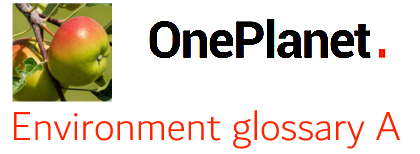OnePlanet is for people who speak English as a second or third language
A B C D E F G H I J K L M N O P Q R S T U V W X Y Z CLICK for list of all the words
A is for: |
: |
aeration"To aerate" is to put more air into something. Not into a football or an airbed (that's "to inflate") but into earth or water. Earth needs air because plants and animals need nitrogen, oxygen, etc. If there are lots of worms and insects in the earth, they will aerate it by making small holes. Earth may not have enough air if there is too much water in it, or if too many heavy objects like cars go over it. Gardeners sometimes help by making lots of small holes in the ground, with a garden fork. Water needs air mainly because water plants and animals need oxygen all the time. In fact, when we talk about aeration of water we usually mean "oxygenation". Water gets oxygen when it is in contact with air, but sometimes that isn't enough. There may be a problem with low oxygen levels if there is too much life in a small volume of water. This often happens if there are too many dead leaves in a pond or small river. The micro-organisms that eat dead leaves also use oxygen. See Ponds Full of Life. A gardener can help to aerate water by putting a fountain in a fish-pond. |
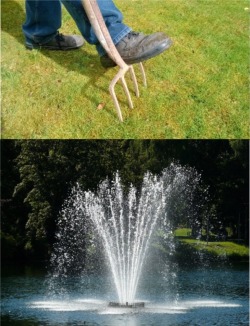 |
airAir is the usual name for the Earth's atmosphere. For us, the most important parts of air are oxygen (O2) and carbon dioxide (CO2). We all think that plants produce the oxygen we breathe, and so they do. Most oxygen in the air comes from tiny plants floating in the sea (phytoplankton). The rest comes mainly from green plants on land. However animals and plants both "respire"; they take in oxygen and release CO2. The difference is that, during the daytime, green plants make more oxygen than they use, so they put oxygen into the air. Can you put the four biggest components of air in order? oxygen
nitrogen
carbon dioxide
argon
It's because carbon dioxide is only a tiny part of the atmosphere that human activity can increase it to dangerous levels. What makes CO2 dangerous? It's a greenhouse gas; it lets the sun's heat in, but it stops warmth from the Earth getting out again. See Climate Change. We breathe in, we take oxygen out of the air, we breathe out, we put carbon dioxide into the air. But we don't take out all the oxygen. The air we breathe in has 21% oxygen; the air we breathe out still has 16% oxygen. If you're in a submarine and the air system breaks, you will soon start to have problems. You will be desperate for air, you will breathe faster, your heart rate will increase and so will your blood pressure. You start to feel sleepy and confused, you get a headache, and when the level of CO2 goes much above 5%, you die. That isn't because there's no oxygen in the air. There's still plenty of oxygen, but the CO2 combines with the water in your blood to make carbonic acid (H2CO3). When your blood becomes too acid (acidosis), your body stops working. You need some fresh air. Image by: Nicholas of OnePlanet and Linguetic. |
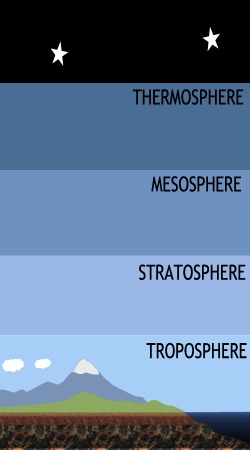 |
algaeThere are microalgae and macroalgae. Microalgae are the microscopic phytoplankton that live in salt water and fresh water, such as Chlorella and Spirulina; and the green fibre that grows in fresh water, such as Spirogyra. Macroalgae are bigger and stronger, they grow in the sea and they can be anything from a few millimetres to 65 metres long. To most English-speaking people, anything that grows in the sea and looks like a plant is "seaweed", but there are two kinds. Seagrasses like Zostera are not algae, they're flowering plants that live underwater. Just like land plants, seagrass has roots, stems, leaves, flowers and seeds, and it needs mud or sand for its roots. It can't grow on solid rock. That's one kind of "seaweed". Wrack (Fucus) and kelp (Laminaria) also have stems and leaves, but they don't have flowers and they don't have roots, either. They have a "holdfast" that looks like roots, but it's just to hold onto a rock. We call wrack and kelp "seaweed" but they're really algae. In the English-speaking world, "algae" usually means microalgae. Most English-speaking people are surprised to hear that seaweeds are usuually algae. Algae are like simple plants, because they have chlorophyll and they produce oxygen by photosynthesis. Microalgae in the sea produce about half the oxygen in the air. However, some microalgae are more like animals - they move around and eat things. Some algae are green, others are brown, red or even blue. If you get green marks on your clothes from a tree or a rock, that's probably Pleurococcus (or Protococcus) algae. |
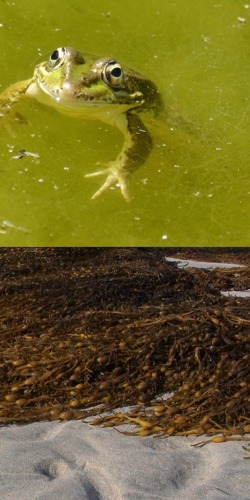 |
an allergyAn allergy is a reaction your body has to a particular thing (an "allergen"). The thing itself is not bad; the problem is the way your body reacts to it. An allergen can be something from a plant or animal, or some kind of chemical or metal. The reaction may happen when you touch the allergen, eat it, or breathe it. It can be a small reaction like sneezing or getting small red marks on your arms for a few days, or a really serious reaction that makes it difficult to breathe. When there's a lot of flower pollen in the air, a lot of people get "hay fever" (allergic rhinitis). This feels like a cold or flu, and it also makes your eyes sore. Different people are allergic to different kinds of pollen. The girl in the picture is standing in a field of "oilseed rape". This is a very common farm crop. It's used to make vegetable oil for cooking, and biodiesel for vehicle fuel. Americans call it "canola" and the Latin name is Brassica napus. Oilseed rape pollen doesn't often cause the true allergic response of hay fever, but it does contain irritant chemicals and it gives a lot of people the symptoms of hay fever. Image by: Cenczi on Pixabay. |
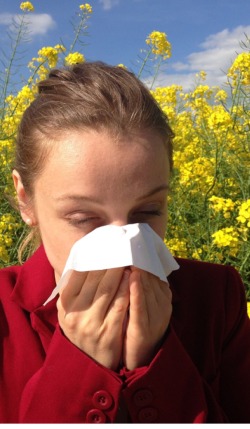 |
an animalOne way to classify books is into hardbacks and softbacks; one way to classify life is into five, seven or nine "kingdoms". If you go for seven, they would be Animalia, Plantae, Fungi, Chromista, Protozoa, Archaea and Bacteria. So, if you're a biologist you could say that an animal is any member of the Animalia kingdom, from a 170-tonne whale to things so small you need an electron microscope to see them. But what about ordinary English? There isn't really a generic word for everything in the Animalia kingdom. In everyday English, only mammals and reptiles are "animals". Birds are ... well ... "birds"; fish are “fish”; and bacteria in ordinary English are (yes, you guessed it) "bacteria". Most people don’t talk about worms, spiders, insects or small arthropods, small marine creatures or any microscopic life, as “animals” either. If you want an ordinary word to talk about spiders, insects and small arthropods, you can call them "bugs" or (if you're under 12 years old) "creepie-crawlies". To a naturalist, they're all "invertebrates". If you want an ordinary word for microscopic animals, from bacteria and protozoa to tardigrades and rotifers, you can say "microscopic life" or "micro-organisms". Image by: Schwoaze on Pixabay. |
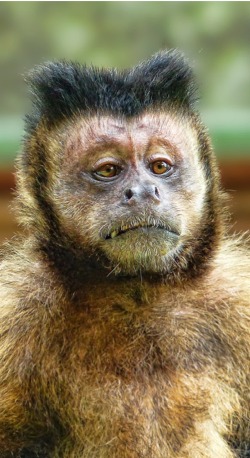 |
an antherWhen you look at a flower, you can usually see small yellow objects on the end of thin filaments. If you look closely, you can see that the yellow comes from pollen grains. The filament and the anther are the "stamen", the male part of the flower. The picture shows a hoverfly on the anther of a lily flower. Hoverflies (Syrphidae) are like bees in that they're important pollinating insects for flowers, fruit and vegetables. Image by: Meli1670 on Pixabay. |
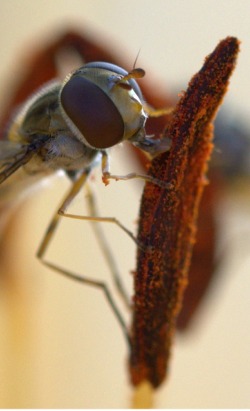 |
an apex predatorThe apex of a pyramid is the top. If you think of living things as a pyramid with plants at the bottom, then an animal like a tiger (Panthera tigris) or a wolf (Canis lupus) is at the apex because it is a predator itself, but it has no predators. Nothing tries to kill and eat it. |
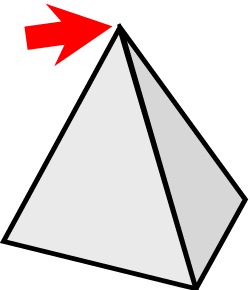 |
an aphid (Aphidoidea)Aphids are small insects that live on sap (plant juice). There are thousands of different species, but they are all small, soft and slow. They reproduce very fast, they damage plants and they often carry disease. They can be a problem for farmers and gardeners, who call the different species "greenfly", "blackfly" and "whitefly". However, they are an important food for many insects that pollinate fruit and vegetable plants. Important insects that like to eat aphids include hoverflies (Syrphidae), ladybirds like Coccinella septempunctata and lacewings like Chrysoperla carnea. Plant sap contains a lot of sugar, and aphids produce a sugary liquid called "honeydew". Some species of aphid have a special relationship with ants, which "farm" them for their honeydew. Image by: Meli1670 on Pixabay. |
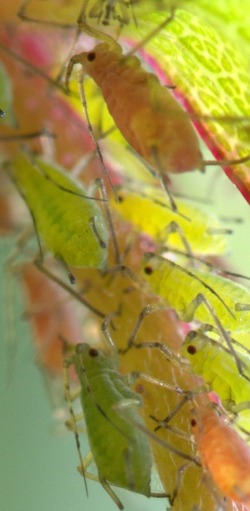 |
an appleEurope has always had the crabapple (Malus sylvestris). This is a wild fruit tree, but it's not very nice fruit. It's not large, crisp and sweet, it's small, hard and sour. The apple we all love for its size, juiciness and sweetness is Malus pumila, which comes from a non-European wild apple (Malus sieversii, a sweet apple that was domesticated in the Tian Shan mountains between China, Kyrgyzstan and Kazakhstan). Image by: Capri23auto on Pixabay. |
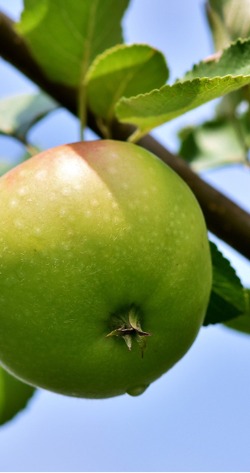 |
arboreal"Arboreal" means "living in trees". A dormouse is arboreal. If an animal is "exclusively arboreal", like the pygmy anteater (Cyclopes didactylus) then it never comes down to the ground. Other words that start with "arbor..." include "arborist", which is basically a person whose job is to cut parts off trees in towns; and "arboretum", which is a park with a collection of different tree species. Image by: Cristina Sanvito, Creative Commons BY 2.0 |
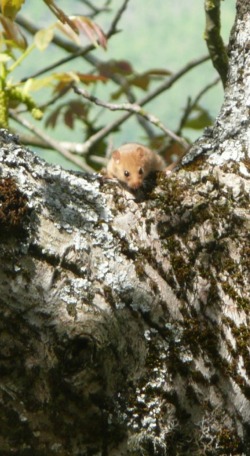 |
ash trees and diseaseThe ash tree (Fraxinus excelsior) is an important part of the landscape in northern Europe. In Britain, it's the second most common tree after oak. It's a big, handsome tree that can live for 400 years. It's not an evergreen tree which keeps its leaves all year round, it's deciduous (it loses its leaves in winter). It's a broadleaf, which means it has wide, flat leaves, not needles like a pine tree. Like most deciduous trees, the ash is an angiosperm. In other words, it's a flowering plant; it has flowers at some times of the year. Ash flowers are not very obvious, though. They're hard to see, not like cherry tree blossom or Robinia flowers which sometimes cover whole trees for three weeks in spring. Every tree wants its seeds to travel, so that they don't try to grow right next to the parent tree. Different species of plant have different strategies for this. They may use animals, birds or water to send their seeds to new places, and the ash uses the wind. Its seeds have a single wing, like the wing of an aeroplane. As they fall from the tree, they rotate very fast. This gives them some lift, so they fall quite slowly. If it's a windy day, they can end up hundreds of metres from the parent tree. This kind of seed is called a samara. The wood of the ash tree is very good for making furniture and tools. Anglo-Saxon and Viking people knew that it was a strong, durable wood that is easy to cut and shape. The name "ash" comes from the Anglo-Saxon "æsc" or "aesc", which also meant "ship" or "spear" and in Viking myth, the tree that supported the world was an ash called Yggdrasil. Another use for ash wood is burning, in a fireplace or a woodstove. Most wood needs to dry out for six months before it burns well, but ash will burn nicely when it is still green; in other words, when it is fresh from the living tree. Big problems for the ash: Almost all mature trees (ash, pine, oak, any kind of tree) have some kind of infection, typically from fungus. The tree usually has natural resistance to the infection, and it may continue to grow and reproduce quite happily for another hundred years. However, there is a problem if the tree is infected by a new disease or fungus to which it has no natural resistance. Hundreds of millions of European ash trees are now being killed by Ash Die-Back or Chalara. This is a fungal disease caused by the chalara fungus, Hymenoscyphus fraxineus. Chalara was brought to Europe from Asia by international trade. It first arrived in Poland in 1992 and has now spread across the whole of Europe, infecting tens of millions of trees and killing many of them. (And American ash trees are being killed by a beetle called the emerald ash borer, Agrilus planipennis. Again, this was brought from Asia by international trade. It first arrived in America in about 1990.) A species that is no problem in its home environment often becomes an "invasive species" if you take it to a new environment. In Asia, the chalara fungus lives on the Manchurian ash, Fraxinus mandschurica, but does not damage it, because the Manchurian ash has had thousands years to develop a natural resistance to the fungus. (And the emerald ash borer is not a big problem in Asia, because it has various natural predators.) "Invasive species" like these are one of the costs of globalisation, which is the use of cheap air, sea and road transport to move things (from coal to bananas) around the planet. There are lots of other examples. When we talk about invasive species, we usually mean things large enough to see, such as kudzu and zebra mussels in the USA, rabbits and cane toads in Australia, cockroaches and parakeets in London, and no doubt other species in your country. However, microscopic species - viruses, bacteria and parasites - often cause the most damage. Economists who talk about the advantages of globalisation don't mention damage by invasive species, which costs tens of billions of dollars, pounds and euros (not to mention yen and yuan) every year. Invasive species also make permanent changes to agriculture, forestry, fisheries and the landscape. With ash die-back in Europe, there are two opinions. One is that infected ash trees should not be cut down. Even within a species, there is always some genetic diversity, so some ash trees will have natural resistance to chalara. If we leave infected trees, we can see which of them have resistance, and we can use seeds from those trees to repopulate other areas. Also, the chalara fungus spreads by tiny spores that are carried by the wind. They can easily travel 20 or 30 km, and probably arrived in Britain by coming across the English Channel on the wind. Obviously, cutting and burning one infected ash tree will not stop the infection spreading. It makes sense to cut and burn infected ash trees that are next to roads or houses, so that they don't fall on people. The other opinion is that any infected tree should be cut down. Salisbury Plain is an area of southern England that is largely owned by the Ministry of Defence and used for military training. The MoD has about 3 million ash trees altogether. In January 2020, the MoD announced that it intends to cut down 14,000 infected ash trees over a three-year period. Here's a quote from a BBC news article: "Judith Peachey, a forester for Landmarc which carries out much of the day-to-day management of the estate, said: 'We're going to devastate the landscape. We're going to remove a large number of trees but it also gives us the opportunity to restructure our woodlands and replant with native broadleafs, so we're not actually going to lose the woodlands themselves, we're just going to have woodlands here in a slightly different form." The "native broadleafs" which Landmarc can use for replanting unfortunately do not include the other classic tree of the English countryside, the elm tree Ulmus procera. That's because nearly all elm trees in Europe were killed by another invasive species in the 1970s. That was Dutch Elm disease, which actually came from Canada. It is caused by Ascomycota fungi and carried not by the wind but by elm bark beetles. The elm tree is not extinct, because the elm bark beetle only likes trees with thick bark. Young elm trees don't have thick bark. Also, elm which is constantly cut to less then 3 metres tall because it is part of a hedge never develops thick bark. Some elm cultivars have been found that have natural resistance to the fungus, and they are being used for replanting. However, if you want to see a mature elm tree, you will have to look at a classic painting of the English countryside, for example the work of John Constable. You can also see mature elm trees in Amsterdam, Edinburgh and Brighton, because it is possible to control the Ascomycota fungus by anti-fungal injections, and it is possible to control the elm bark beetle by cutting down infected elm trees. And Landmarc will probably not plant another beautiful broadleaf tree, the sweet chestnut (Castanea sativa) because that is being killed by another invasive species, a water mould called Phytophthora ramorum. Ramorum disease is also killing millons of larch (Larix) trees in Britain. A variant of Phytophthora ramorum is now killing millions of oaks (Quercus) and tanoaks (Notholithocarpus) in north America, where it is called Sudden Oak Death or SOD. Nobody knows where this invasive species comes from, but the most likely explanation is that it came with exotic plants for gardeners, brought from Asia. Globalisation is economically great for China and India, but not so great for other economies or for the natural world. |
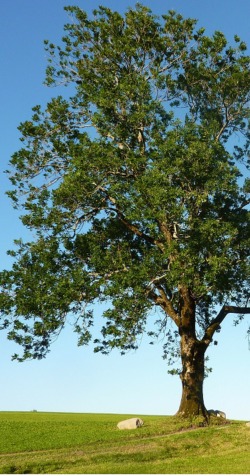 |
...New words every week; CLICK HERE for a full list |
 |
* |
* |
A B C D E F G H I J K L M N O P Q R S T U V W X Y Z CLICK for list of all the words
